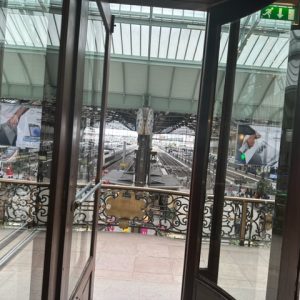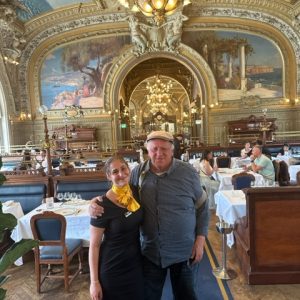Le Train Bleu, Gare de Lyon
The great railway stations of Paris are wonderful architectural monuments which glorify the industrial revolution. Indeed, the nineteenth century marked the start of the golden age of rail. Trains powered by steam engines carried goods and people faster than ever before and reached new destinations, connecting businesses to new markets.
These railway stations are massive, elaborately decorated, and clearly built to impress. Many of these railway stations are works of art in their own right. Their main competitors in urban architecture are the cathedrals of the “Isle de France”, the region surrounding Paris, built during the Age of Cathedrals, from the 12th to 14th centuries – like Basilica of Saint-Denis and Notre-Dame de Paris.
The great railway stations of Paris include: Gare du Nord opened in 1846; the Gare de l’Est and the Gare de Lyon opened in 1849: the Gare Montparnasse in 1852; the Gare Saint Lazare in 1867; and the Gare d’Austerlitz in 1869. All over France, provincial cities followed suit, constructing some of the most impressive public buildings ever built without a religious or a royal purpose.
The artistic value of these railway stations in symbolised by the transformation of the former Gare d’Orsay, a Beaux-Arts railway station built between 1898 and 1900, into the Musée d’Orsay.
The current Gare de Lyon was built for the 1900 World Exhibition, and is probably the most beautiful station in Paris. The Buffet de la gare, the future Train Bleu restaurant, was inaugurated in 1901 by the President of the Republic, Emile Loubet, and quickly attracted high society and artists. In 1963, the buffet became “Le Train Bleu” , in homage to the “Paris-Vintimille” line dating from 1868, a legendary train which served the towns of the Côte d’Azur, running along the Mediterranean.
Le Train bleu is a must for visitors to Paris, with a sense of both history and style. I have been there several times, including last week. This neo-baroque and Belle Époque style gourmet restaurant is magnificent and is located on the 1st floor of the hall of the Paris-Gare de Lyon train station. Fortunately, it was saved from demolition in 1966 by the French novelist and art theorist, André Malraux, when he was also minister of cultural affairs.
For a wine walker like me, Le Train Bleu is almost unavoidable. As I travel by train for my walks in Burgundy, the Rhone Valley and even Switzerland, I am frequently passing through the Paris Gare de Lyon. Fortunately, Le Train Bleu is not a tourist trap like many spots in Paris. It combines beautiful decor with traditional French cuisine, under the leadership of great French chef, Michel Rostang.





